When I chose my first DSLR many years ago I chose a Nikon. Since then I’ve stayed with the brand into the Z mount era. When I went back to film in 2016 it was with a Nikon F3, and since then I’ve shot with most of Nikon’s pro and mid range film cameras, including the mighty F6, the engineering miracle that is the FM3A and the camera that took Nikon to market dominance in the SLR market – the Nikon F. This is its story.
Genesis of the Nikon F
The story of the Nikon F starts in the rangefinder era which began with the Leica I of 1925. A milestone in photographic history, the Leica I popularised the use of the accessory rangefinder. The Leica II and Zeiss Contax I with their built in rangefinders put the technology firmly on the map, and by the late 1930’s the low-cost Argus C3 rangefinder was the world’s best selling camera.
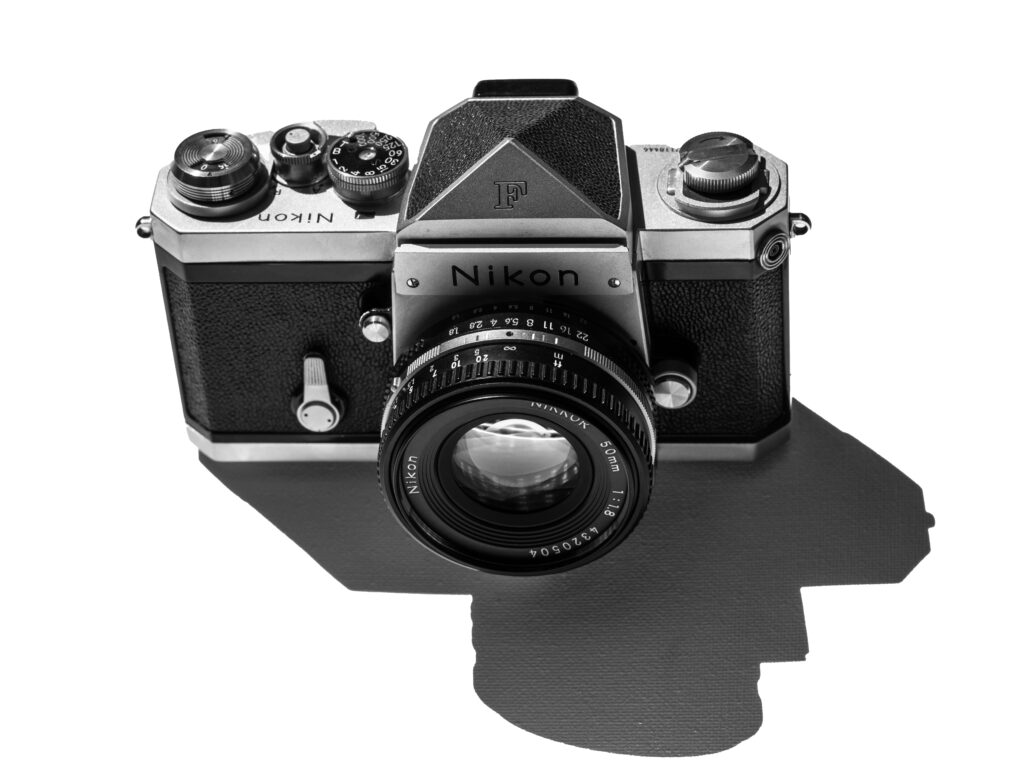
The Nikon I Rangefinder
Fast forward to post-war Japan. After WWII the Japanese camera industry was getting back on its feet. Nippon Kogaku K.K. (as Nikon was known until the late ’80s) introduced a 35mm rangefinder, now known as the Nikon I, which used a shutter and rangefinder mechanism based on the Leica II. However, the Nikon I bore a greater resemblance to the Contax rangefinder with a similar top focus wheel, removable film back, and a slightly modified Contax bayonet lens mount. It was launched in 1948 – about the same time as the Konica I rangefinder (also reviewed on this site).
By the late 1950s Nippon Kogaku (henceforth ‘Nikon’) was selling well engineered 35 mm rangefinder cameras such as the Nikon SP of 1957 (Nikon’s first professional camera) and the S3 of 1958 in competition to Leica. However, a limitation of the rangefinder was that telephoto lenses with a focal length of 135 mm or more required a cumbersome optional reflex box.
The Nikon SLR Development Program
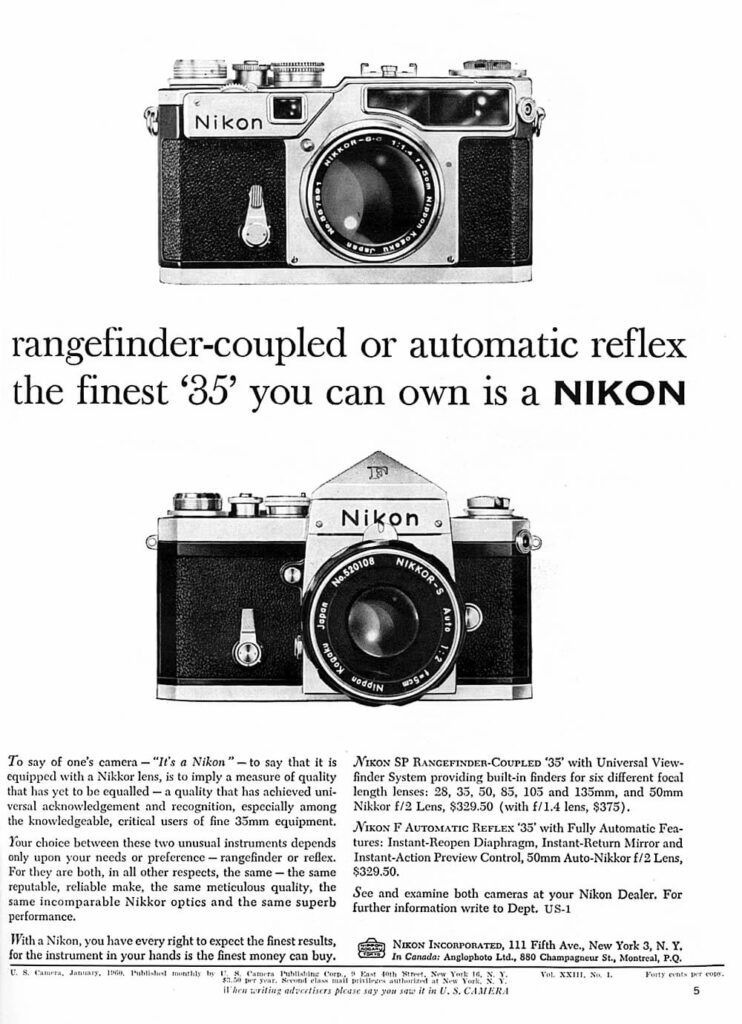
Single-lens reflex cameras (SLRs) had the advantages of the reflex box integrated in the camera. Nikon recognised the future potential of SLR cameras and in 1955 launched a program for their development in parallel with their rangefinder models.
The trial Nikon SLR model was based on the body of the Nikon SP, with a mirror box inserted. Only the mirror box, pentaprism and bayonet mount were newly developed. The new camera was designed by Yoshiyuki Shimizu and his team, who sought to create a system camera that could be adapted to a wide range of photographic situations.
The Birth of Nikon F, 1959
in 1959 when Nikon launched the The Nikon F, SLRs had been available for years but had not gained great acceptance by professionals. This was due to their weight, reliability, and dim viewfinders, when compared with the professional standard – the Leica M3.
The SLR deficit
The deficiencies of most post WWII SLRs are described by Nikon’s Camera Chronicle: “Before focusing, the user had to set the lens aperture to its maximum setting to brighten the viewfinder with shallower depth of field. After focusing, the user had to manually adjust the lens aperture to the desired setting. If he did not do this, the photo would be overexposed. When the shutter was released, the viewfinder became dark. The user couldn’t check composition and lost track of moving subjects. After the film was advanced to the next frame, the mirror returned to its original position. Only then did the viewfinder brighten”…… The Nikon F would change all that.
Five Features that changed the photographic landscape
With the Nikon F, Nikon introduced an SLR that could compete with the rangefinders, combining several concepts that had already been introduced elsewhere into one extremely versatile camera:
- Interchangeable bayonet lens mount (Kine Exakta, 1936)
- Pentaprism viewfinder (Contax S,1949)
- Interchangeable Viewfinders and focus screens (Exakta Varex,1950)
- Instant return reflex Mirror (Asahiflex IIb,1954)
- Automatic diaphragm for wide open composition (Zeiss Contax/Pentacon F 1956)
Or was it six?
The Nikon’s F Titanium foil focal plane shutter added a true ‘first’, but it was the incorporation of existing important innovations in one camera that changed the camera landscape, making the SLR an attractive option for professionals.
You want more reasons?
For a professional considering the camera there were other factors that made it attractive. Firstly, the combination of the automatic diaphragm and instant-return mirror made it faster than competing SLRs. Secondly, it had the same acclaimed control layout as the high-end Nikon SP rangefinder. Thirdly, the viewfinder was relatively bright and evenly illuminated due to the Fresnel lens integrated into the focusing screen. Lastly, the Nikon felt solid but was relatively compact and not overly heavy as the body dimensions (except for depth) were quite close to those of the SP.
Nikon had, in one camera, eliminated most of the disadvantages of the SLR versus the rangefinder, leaving just its advantages apparent. The Japanese company also had two other very strong cards to play, both of which had their origins in Nikon’s engineering excellence – reliability and flexibility.
Reliability
Nikon ensured reliability by subjecting the camera tests of endurance, heat run, low temperature durability and vibration to ensure that it could withstand hard use under any conditions. The shutter endurance test was particularly tough with 100,000 cycles of repetitive action, conducted with the aid of its motor drive.
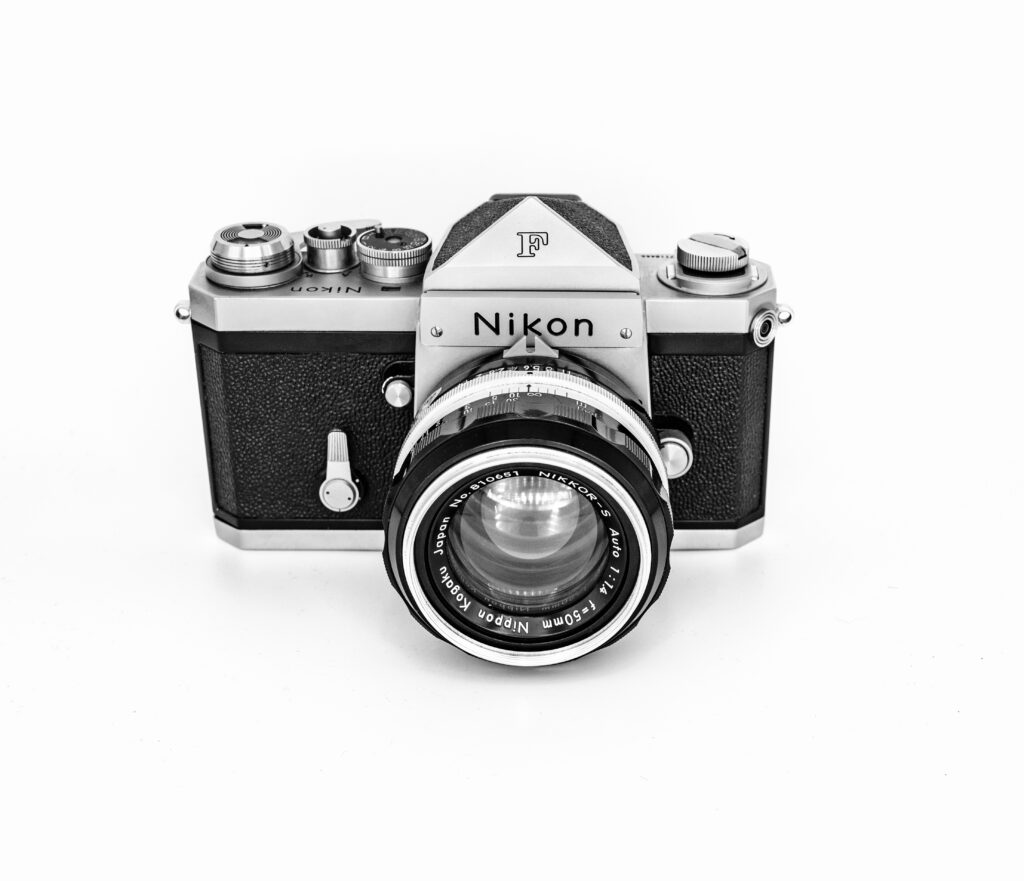
The result was a camera so tough it became known as “the hockey puck” for its ability to withstand damage and resist mechanical failure. Accordingly it was selected for extreme missions such as space with NASA, combat (notably the Vietnam war) and exploration (Everest, in 1963).
Flexibility – The System Camera
The Nikon F was designed as a system camera, enabling its use with a variety of viewfinders, choice of focusing screens, motor drives, and other accessories. At launch, Nikon offered an extensive selection of lenses ranging from wide-angle to telephoto, including the fast 58mm f/1.2 standard lens.
Once again, the concept of a modular camera had existed prior to the Nikon F, but Nippon Kogaku improved upon it with an impressive array of options. The first camera to introduce the concept was the Leica I of 1930 which had a standardised interchangeable screw mount lens and an accessory shoe.
The F Mount
The Nikon F incorporated a new bayonet mount, the F-mount, which featured a large diameter and a short flange distance to accommodate a wide range of lens designs. Moreover, the F Mount’s design enabled extraordinary longevity and allowed Nikon to become the leader in lens/camera compatibility. The F-Mount accommodated advancements such as AI (Automatic Indexing, 1977) and AIS (Automatic Indexing Shutter, 1983) in and is one of only two SLR lens mounts (the other being the Pentax K-mount) which were not abandoned by their manufacturer to introduce autofocus.
Four Historic Turning Points
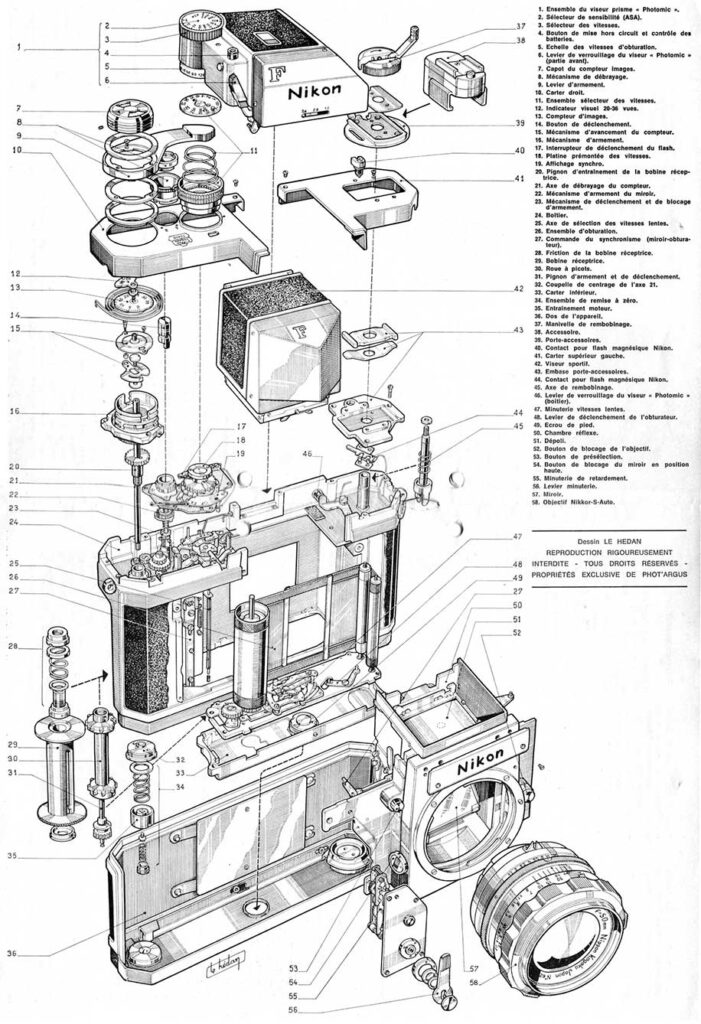
Upon its release, the Nikon F received widespread acclaim for its design, durability, reliability, and flexibility. The camera’s significance extends beyond its technical capabilities, marking a turning point in the photographic industry, establishing three turning points in the history of photography:
- Signalled the end of the rangefinder era and the rise of the SLR
- Established the SLR as the camera of choice among professional photographers, especially photojournalists and those working in challenging environments.
- Promoted Nikon to a leading brand in the photographic industry with Leica losing ground
- Established the rise of Japan as the leader in the photographic industry, with Germany losing ground
Notable Users
The Nikon F had many users of note, such as renowned photographers David Douglas Duncan, Gordon Parks, Don McCullin and Bert Stern. NASA took an F into space; it became one of the key instruments documenting the Vietnam war, and the F is associated with possibly the most iconic photo shoot in history. Below are some of the highlights.
David Douglas Duncan and LIFE Magazine
In June 1950, David Douglas Duncan, (aka DDD) a renowned photographer at LIFE Magazine visited Nikon’s Ohi Plant with Fortune’s Horace Bristol. Guided by Nikon President Masao Nagaoka, they compared their Leitz and Zeiss lenses to Nikkor with Nikon’s projection inspection equipment, determined that the Nikkors were superior and bought M Mount Nikkor lenses for Leica.
When the Korean War broke out shortly afterwards, DDD went to the front line with two Leica IIIc’s equipped with a Nikkor lenses. Subsequently, he was joined by Carl Mydans, also from LIFE, who also visited Nikon and bought Nikkor lenses for his Contax rangefinder.
The two photographers took almost all of the pictures of the Korean War carried by LIFE with their Nikkor lenses, and won the “U.S. Camera Awards” of 1950. Subsequently, the Nikon rangefinder and it’s Nikkor lenses became popular with all LIFE photographers. Their reputation quickly spread throughout the US and the rest of the world and helped establish Nikon as a global brand.
NASA Missions
The Nikon F’s journey into space with NASA began with its modification for the Apollo 15 mission in 1971. This included reformulating adhesives, redesigning the battery chamber, and enhancing the durability of plastic parts. The film advance lever, shutter release, and film rewind mechanisms were also modified to facilitate ease of use by astronauts wearing gloves. Additionally, the (ISO) dial was re calibrated to match the the film emulsions developed for NASA missions.
The Nikon F in the Vietnam War
The Nikon F was adopted by many photojournalists during the the Vietnam War, which became one of the most photographed conflicts in history. I grew up with the Vietnam War on the news but realised how little I understood about it when I read Max Hasting’s Vietnam: An Epic Tragedy, 1945-1975. It is an astonishing story, and a tragedy on a truly epic scale.
The Nikon F’s robust design made it ideal for photographers working in the difficult and unpredictable conditions of Vietnam. It was subject to jungle humidity, dirt and dust, and the rough handling that came with working in a conflict zone. David Douglas Duncan, who we met earlier, Eddie Adams, Nick Ut, Tim Page and Don McCullin all used Nikon F cameras during the Vietnam War.
It wasn’t the only tough camera of course, some Vietnam War photographers would take the Nikon F for normal/long lenses and a Leica for wide angle lenses.
One of the most famous stories about the Nikon F and the Vietnam war is how it saved a British Photographer’s life. In 1968, Don McCullin was documenting the Vietnam war for The Sunday Times Magazine. While stationed at Prey Veng he was spotted by a Cambodian solider who opened fire. McCullin had his Nikon F to his eye, and the bullet from the AK-47 struck the the solid brass top-plate of the Nikon, deflecting the round and saving his life
There are many other stories. I found an excellent account of a soldiers experiences in Lee Dudley’s Nikon F and the Vietnam War
Bert Stern, Marilyn Monroe and a Nikon F
Portrait photographer Bert Stern received a phone in June 1962 which resulted in one of the most famous celebrity photoshoots in history. Stern waited for hours for Monroe to appear in her Bel-Air Hotel, accompanied only by his Nikon F, but it gave him the opportunity to photograph her for next 12 hours and resulted in 2,571 photos. Marilyn Monroe would die only six weeks later, and the images, known as The Last Sitting, became iconic.
The Nikon F in the movies
The first of Nikon’s SLRs was quite the film star, as described in Michael Pritchard’s excellent book ‘A History of Photography in 50 Cameras‘.
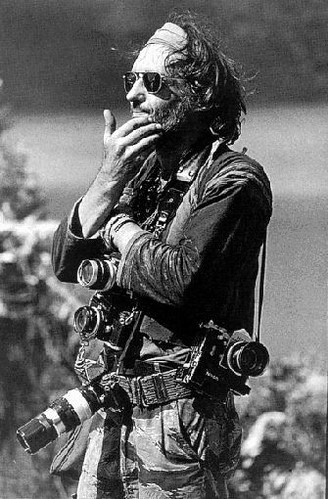
“The Nikon F reinforced its reputation and established itself as modern design icon through its starring roles in films such as Blow-Up, with David Hemmings as a fashion photographer in London; Apocalypse Now with Dennis Hopper as a Photojournalist; and, later, with Clint Eastwood as National Geographic photographer in The Bridges of Madison County.”
Clint Eastwood’s Nikon F was eye catching in black with an chrome eye-level prism, but for me it has to be Dennis Hopper, festooned in Nikon Fs, as a crazed Photojournalist in Francis Ford Coppola’s Apocalypse now that steals the show. I found Hopper’s role interesting enough to write an article on it: The Photojournalist of Apocalypse Now.
There are the other films the Nikon F plays a part in: Blow-Up (1966); The French Connection (1971); Diamonds are Forever (1971); Apocalypse Now (1979); Cannonball Run (1981); The Year of Living Dangerously (1982); The Killing Fields (1984); Full Metal Jacket (1987); Gorillas in the Mist (1988); Groundhog Day (1993); The Bridges of Madison County (1995); City of God (2002); Walk the Line (2005); Ford v Ferrari (2019).
Nikon F Hall of Fame
You can also peruse an excellent Nikon F Wall of Fame, featuring the likes of Mick Jagger, Sean Connery and many more.
Shooting with the Nikon F
The Nikon F still has some rangefinder DNA so loading film isn’t like other Nikon SLRs. I am not a big fan of the bottom-loading system, but if I was shooting regularly with the F, I’m sure I’d get used to it. Other than that, it’s remarkably straightforward.
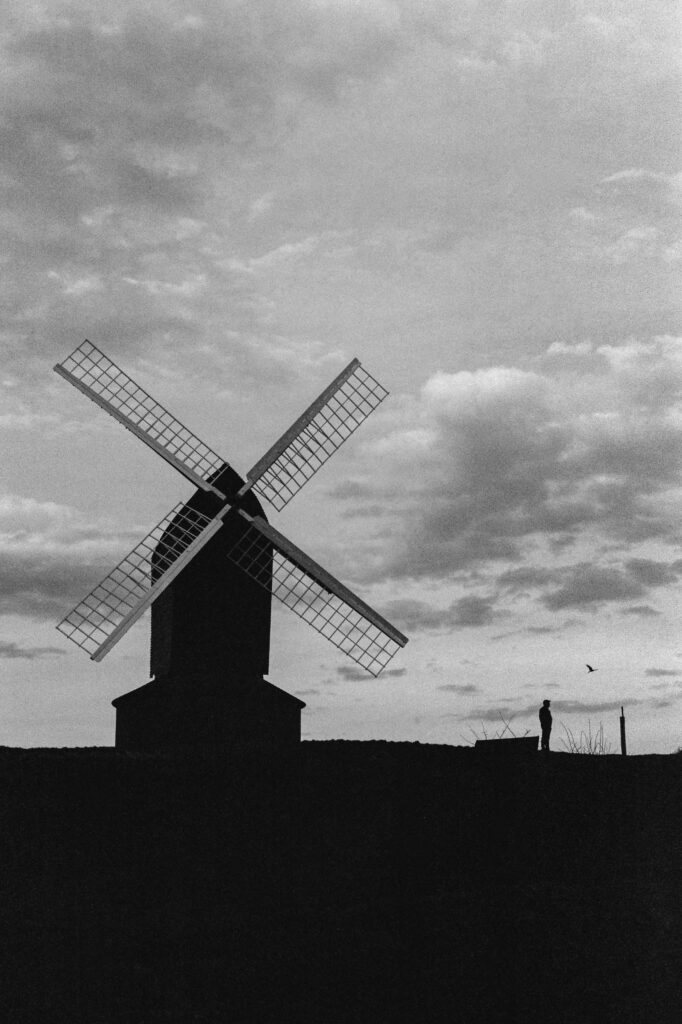
Loading Film
To load film, you turn the lock on the bottom plate from ‘closed’ to ‘open’ and the camera’s bottom plate and the back cover come away as a single unit. Next, insert the 35mm film roll into the film chamber on the left side, and then thread the film leader onto the take-up spool on the right as normal.
You will need to set the ‘A-R’ ring around the shutter release button on the top plate to “A” (Advance), then wind the film on so that it passes under the take-up spool, ensuring the film meshes with the sprockets. After that, you can then replace the camera back and lock it by turning the lock to the “close” position. The shutter can then be cocked and released until the frame counter displays “1”. The counter resets itself automatically to two frames before zero when the camera back is removed, so it should just be two shots.
Speaking of which, the frame counter is located in the centre of the film advance lever. Opposite the frame counter is a reminder of the total number of frames – this is set manually using a tiny indicator pin on the dial.
On the bottom plate there is film-speed reminder which can be set manually to indicate colour or black and white film and to set a reminder of the ISO. One quirk is the flash sync, which consists of a pair of vertical contact points either side of the rewind knob for the F accessory hot shoe.
Shooting
After loading the Nikon shooting is extremely simple straightforward. With the eye level finder the Nikon F offers no light meter, and there’s no automation. You just set the aperture and shutter speed and focus. The viewfinder, unencumbered by a light meter display, provides a clear, bright view of whatever you are shooting. The maximum shutter speed is 1/000 if a second which is fine unless you are shooting with a large aperture on a very bright day.
Serial Numbers and Model Variants
Nikon F bodies were produced between March 1959 and October 1973. You can date your camera from the serial numbers. The earliest Fs are 640xxxx.
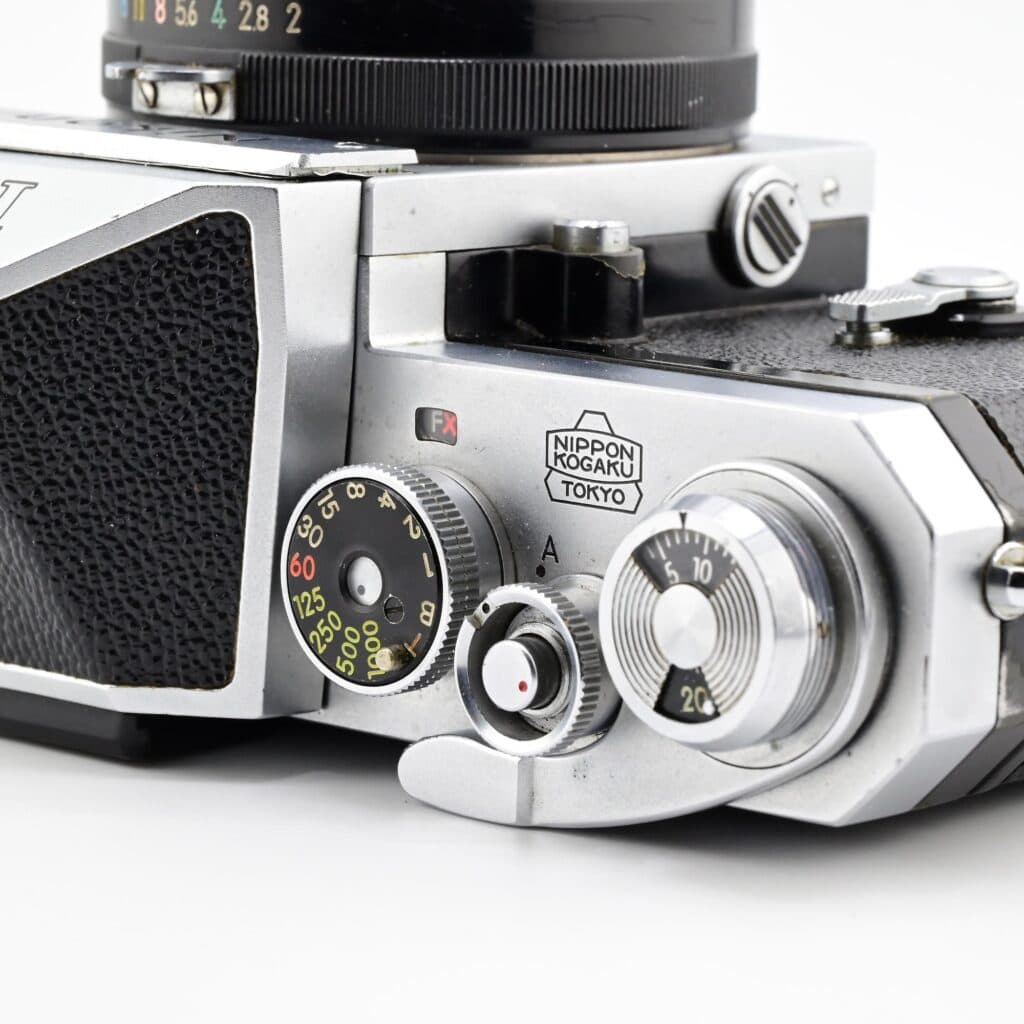
Early Nikon Fs can also be identified by a self timer with slanted serrations, a prism engraved Nippon Kogaku rather than screen printed, a back with patent pending numbers and marked ‘Made in Japan’ on the closing lock. Later models had this inscription on the baseplate near the tripod socket. Sometime in the 67xxxxx series the inscription on the top plate changed from the Nippon Kokaggu triangle to Nikon. This detail is shown left from an early (first 1000) model which at the time of writing was for sale at Grays ofWestminster.
The latest series was 745xxxx, and the very last model was 7451052. Based on that we can tell that around 745,000 cameras were shipped.
Nikon gave the 500,000th F to the photographer who had the biggest impact on the rise of Nikon, David Douglas Duncan.
The Nikon F ‘Apollo’
This is less exciting than it sounds, as the late model ‘Apollo’ variant of the Nikon F has minor cosmetic changes to match parts used on the F2 which was in production by that time. There is no actual link to the space program, other than time of manufacture. The Apollo updates are a plastic-tipped F2 type advance lever and self timer and stronger strap eyelets and start at 7335000. Later Apollos had an F2 type threaded PC connection also. Around 116,000 ‘Apollo’ Fs were produced.
The Nikon F Red Dot
In 1965 when Nikon introduced the first TTL metering finder, Photomic T, the top plate of the Nikon F was slightly revised and Nikon added a red dot in front of the serial numbers to designate the modified bodies. The red dot appears on body serial numbers 659xxxx to 66xxxxx (approximately). Bodies from 67xxxxx onwards incorporated the revision without the red dot.
Motor Drive Models
The F36 motordrive was based on the system pioneered by Nikon’s S2 Rangefinder, the S36 and came from the factory matched and synchronised to a specific body. In this configuration the Nikon F offered offered 3 frames per second (fps). This was with the automatic mirror and diaphragm in operation and maximum speed could be increased to 4 fps with mirror lock up (MLU). There was also a 250 exposure version. In 1971 the F High Speed model delivered a 7 fps with MLU, and in 1976 a new High Speed model bettered this with an equivalent 9 fps for photographers at the Montreal Winter Games.
Finishes
There were two finishes available at launch: satin chrome metal/black leatherette and black enamel. The engraved letters, numbers and symbols are black-filled on chrome-plated bodies or white-filled on black-painted bodies. Well used black Nikon F bodies that display paint wear, particularly on edges of the covers are said to have become brassed, which was a badge of honour amongst professional photographers.
Black eye-level F’s are usually more expensive as they are less common and the association with black with professional photographers. In 2024 a mint copy like this is selling for a little over £1,000 on eBay.
The Photomic Head
The first Nikon F meters were clip on Selenium meters attaching to the top of the camera over the prism and shutter speed dial. Being Selenium meters, they did not need batteries.

The Nikon F’s “flag” Photomic meter head of 1962 introduced the F’s first built in light meter, ingeniously including the prism and meter in one unit. Sadly it is bulky and asymmetric, and to my eyes ugly, but by placing the meter in the prism head assembly, Nikon was able to continually update its metering system at a relatively low cost.
In 1965 the Photomic T introduced TTL (Through the Lens) metering, in 1967 the Photomic TN followed with centre-weighted metering and 1968’s Photomic FTN displayed shutter speeds in the finder. If you are set on a Photomic the FTn has a greater film sensitivity range and a larger aperture coupling range in addition to the shutter speed display, so it makes the most sense.
I’m sticking to my eye level prism. As much as I like a built in light meter, the lines of the Nikon F are just too good to spoil with the Photomic. I have one on my F2 and it feels like a more acceptable trade off, but I just can’t take the ‘F’ off the F.
Purchasing a Nikon F
As with all classic or vintage film camera bodies the main consideration is the condition of the shutter. Whether a beater or a mint example, you want a Nikon F with a titanium foil shutter free of perforations, ripples, or little tears at the edges. If you are able to do a hands on inspection it is also worth checking that each of the shutter speeds trigger the shutter. Shutter speeds can of course drift and become inaccurate over time which is hard to detect pre purchase, but can usually be corrected (or at least improved) with a good CLA (Clean Lubricate and Adjust).
After that check for dark patches in the viewfinder which could be a sign of an ageing prism, which is de-silvering. This is a fairly common problem. Finders tend to be pricey for Fs so getting one with a good prism is important.
I have seen accounts that say the Nikon F does not have door seals – and others that say that it does but they are hard to see and never need replacing! Regardless, there are definitely mirror and prism cushions which can deteriorate, but there are kits available to replace them.
Successor – The F2
The Nikon F had a number of design issues originating from its evolution from the Nikon SP rangefinder, most notably the removable back. Another issue was that electronic metering had been added, rather than designed in from the start. Nikon listened to its user base and developed a successor, with an internal design mantra of “quicker and stronger.”
The new F2 of 1971 offered a rounder body, a swing back and a more comfortable plastic-tipped film advance lever. The F2 was also designed for metering from the start. The battery holder was moved to the bottom of the camera and the batteries were changed to more modern silver oxide cells, activated by an on/off switch that was changed to be a partial pull of the film advance lever.
The result was a mechanical SLR that is considered by many to be the finest ever produced. It is an improved and more practical camera but it does not have the same place in my affections as the Nikon F.
Thoughts and Further Reading
If you have experience with shooting a Nikon F, I’d love to hear from you. Please leave me a comment below. You might also find the following articles on this site interesting:
- The Nikon F6 – Nikon last film camera
- The Nikon FM3A – Nikon’s last manual SLR
- The Nikon F3 – Back to film
- The Nikon FE
- Nikon Film Cameras in the Movies
- The Photojournalist of Apocalypse Now
- The Konica I – Konica’s first rangefinder
- The History of Konica – A history of firsts
- Ten Days in Japan – Travel in Japan
- When Photos Looked Like Paintings – Pictorialism movement
- From Chemistry to Computation (History of Photography)
- Cameras Year by Year (20th Century Camera timeline)